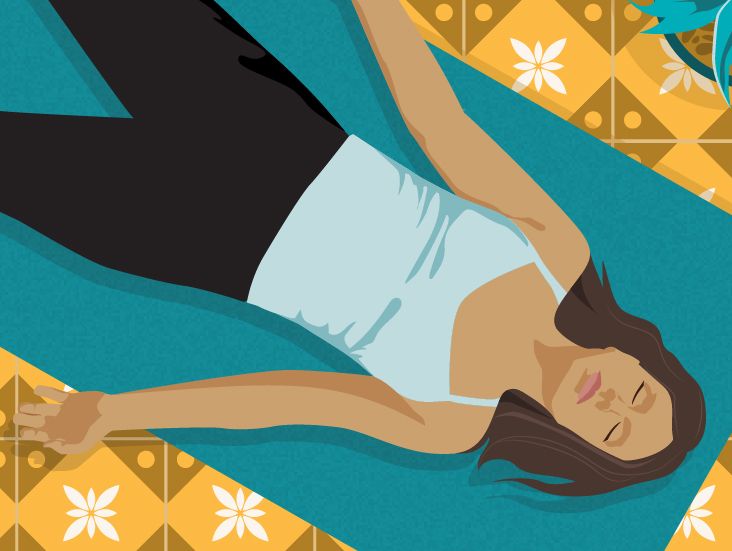Play all audios:
You’ve heard of passive-aggressive and calm-assertive — now a relaxed awareness long practiced in yoga is trending. But can lying like a corpse resurrect lasting inner calm? So here’s how it
went down: Goop referenced head yogi Kirit Thacker of Ananda in the Himalayas, saying, “one session of the ancient practice of Yoga Nidra, which means, ‘psychic sleep,’ is equivalent to
many hours of shut-eye.” A couple years later, this TikTok got more than 387,300 views, among other yoga nidra videos that have gone viral: Then, recently, Bulletproof‘s buzz-generating blog
myth-busted the idea that yoga nidra could _replace_ a full night’s sleep and clarified that you may truly _feel_ rested and restored thanks to the mental fitness yoga nidra provides to
your brain. So, after hearing this, we were wondering, “Is this really a thing?” Well, let’s discuss. Tell ‘ni’ more Yoga nidra (“knee-DRA”), meaning “to yoke sleep,” is an eons-old
technique within the yoga practice that originated in India. It’s more akin to meditation than to the brow-furrowing poses stretching the mind and body in the yoga you might see on TV or in
your local park. The technique involves the yoga position Savasana, or “Corpse Pose.” Though it may _feel_ like you aren’t doing anything calorie-burning or muscle-toning, research shows
that you could be enhancing your mental fitness and time-releasing your sense of inner calm. So, is this just a fancy way of saying ‘power nap’? Yoga nidra is a remix of sorts, infusing
guided sleep meditation while you’re lying down. But it differs from other sleep meditation techniques because your goal isn’t unconscious bliss or deep sleep. And this one difference is
what no one’s really talking about: The end game _isn’t_ sleep — it’s effortless relaxation. Yogic sleep is about blissful consciousness, not slipping into unconsciousness. This is called a
hypnagogic (“hip-nuh-GAH-juhk”) state. In yoga nidra, sleep meditation is used on your body while you practice deep breathing and present-moment awareness in your mind. It’s so freaking easy
that we can count the steps on one hand. Here’s what you do: * Lie on the floor in a quiet space, with gentle support, like a beach towel or yoga mat, under your body. * Let your feet fall
naturally to each side, hip-width apart, and allow your arms to relax alongside your body, with your palms facing up. * Close your eyes or set an unfocused gaze toward the sky. * Choose a
deep breathing method and consider a body scan … then start doing it! * Let your guided sleep meditation steer your mind. When thoughts arise, watch them pass like planes in the sky. If
you’re thinking of trying it out yourself, here’s a great mat to stretch out on: It’s HAPPENING! WHAT HAPPENS IN YOUR BODY While your body is being hacked into the deep relaxation associated
with sleep (while still being alert), you may notice: * heightened present-moment awareness * the physical comfort of grounding * dissipating anxiety and stress symptoms * a fast-pass to
activating your parasympathetic nervous system, the portal for digestion, rest, and recovery from fright, flight, or fight triggers WHAT HAPPENS IN YOUR MIND Several studies have observed
the effects of yoga nidra. Researchers in a small 2022 study observed significant differences in delta brain waves (the most restorative of deep sleep stages) of yoga nidra practitioners
after only 2 weeks. A small 2019 study of 40 university students found that those who practiced yoga nidra experienced a dramatic decrease in life stress intensity and an increase in
self-esteem. In a small 2018 mixed method study of 36 students ages 13–15, participants reported wellness benefits _across the board_ after 1 month of practicing yoga nidra 30 minutes a day,
3 days a week. Although more data is needed, these results suggest that the practice could have some positive effects on the following: * alertness * enthusiasm * clarity of thought *
control over anger * self-confidence * self-awareness * quietude Additionally, a 2017 study recorded significant differences in morning and evening stress among nursing students, _regardless
of the time of day of yoga nidra practice_. This suggests a slow-drip release of induced calm. So, basically … It appears the hype is real, if not an eye-roll for those who have already
made yoga nidra a part of their wellness practice for mind and body. Yes, simply lying down and breathing is a researched method with positive results for restoring mental wellness,
self-confidence, and self-esteem. However, we do not recommend trying to use it as a substitute for good sleep.

